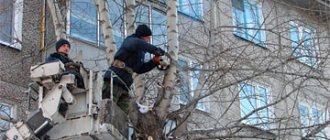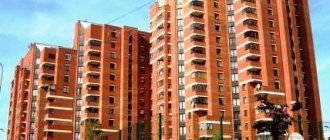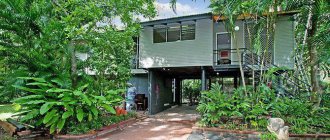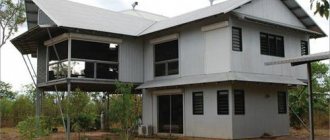When a tree is in the way or poses a danger, and you can’t handle the problem yourself, you have to look for someone who can do the work professionally and legally.
After all, it is necessary not only to safely remove the interfering plant, but also to correctly fill out all the documents, as well as obtain a permit or felling ticket.
These services are provided by organizations that exist in every city.
We have already talked about:
- how trees are cut down;
- who issues permission for this action and how;
- who can initiate this process in certain situations.
In this article we will talk:
- in what cases and where you need to apply and write an application to cut down a tree;
- why you shouldn't do it yourself;
- who is engaged in cutting down and removing fallen trees;
- Is it legal for these organizations to demand money for their services?
Why can't you cut it yourself?
Self-cutting or cutting down even small trees is a complex, dangerous process that requires special equipment and special skills .
Even the slightest mistake can result in personal injury or property damage.
You can read more about cutting down trees yourself, as well as cases when they can be removed manually, here.
The taller the tree, the more difficult it is to cut it down; in addition, the complexity and labor intensity of the process is influenced by plant parameters such as:
- location;
- general state;
- shape of the trunk and branches;
- the presence of nearby buildings, cars or people.
In addition to purely technical problems, there are also bureaucratic ones, because it is necessary to correctly draw up all the documents, then obtain permission to cut down or cut down.
At the same time , the procedure for obtaining a permit is different in each city , because these issues are regulated at the local government level.
Therefore, even if you prepare all the documents in accordance with the requirements of federal law, you may receive a refusal due to errors in execution.
To avoid such problems, you need to entrust the preparation and cutting to professionals; it’s not cheap, but you won’t have to redo documents several times or be responsible for damage caused by an unsuccessfully fallen fragment.
Valuable breeds
Which trees are valuable species and cannot be cut down? Some biological tree species are valuable species , the felling of which is limited and can only be carried out for sanitary reasons or as an exception.
These include rare relict trees listed in the Red Book, or trees that are valuable as a biological resource.
The list of valuable and rare tree species may be determined by regional legislation.
In what cases and to which organizations should I write?
There is no definite answer to this question, because a lot depends on the status of the person who needs the service, that is:
- land owner;
- lodger;
- tenant of the territory;
- representative of the company involved in felling.
No less important is the type of service they expect to receive, that is:
- logging permit;
- registration of a felling ticket;
- sawing
Additionally, the reason why the tree needs to be removed is very important. Therefore, we will analyze various situations and tell you where to turn in this or that case, based on where the tree grows.
In the courtyard
In the courtyards of apartment buildings, a tree can grow on municipal or private territory, because the land around the house is common property and belongs to all apartment owners.
If the plant is located in the local area and interferes with some work not related to home renovation, or grows under a window and blocks the light for residents of several apartments, then you need to start with a general meeting of homeowners.
After all, without the minutes of the meeting, which indicates the consent of all owners and also contains their signatures, contacting a management company (MC) or local administration makes no sense.
After obtaining the consent of all apartment owners (if the tree poses a threat or is unsafe, you can do without the consent of the remaining apartment owners), you must contact the Criminal Code and submit an application in free form and in two copies.
One copy remains with the Criminal Code, and the second with the person who submitted the application, and both copies must bear a mark indicating that the Criminal Code accepted the application, as well as the date/time of this event.
If the management company works normally, then after receiving a statement about the emergency tree, its representatives contact the administration and independently regulate all issues .
Moreover, the payment for cutting is evenly distributed among all residents of the house. If there is no emergency, but the management company is working well, then it is necessary to discuss further actions with its management, because despite the consent of all apartment owners, the management company can seriously complicate felling or sawing.
This is due to the fact that she is the one responsible for the local area and is the representative of all apartment owners. If the Criminal Code is not against cutting down a non-emergency tree, then having received its consent, it is necessary to prepare a package of documents to obtain permission .
It is quite difficult to do this on your own, because it is necessary to comply with the requirements of not only federal, but also local legislation.
Often such services are provided by organizations engaged in tree cutting. In addition, the management company can take over the paperwork ; in any case, these services will have to be paid for. In the process of preparing documents, it is necessary to conclude an agreement with a contractor who will cut down an emergency or interfering tree.
When all the documents are ready, you will need to pay for the contractor’s work and contribute to the district budget an amount sufficient to carry out restoration activities. Only after this can the disturbing/emergency tree be cut down and disposed of.
Under the window
There are situations when a tree in the courtyard of an apartment building disturbs only a small number of apartment owners or residents, blocking their light.
To cut down a tree under a window, you first need to contact the Housing Inspectorate or Rospotrebnadzor to check whether the illumination of the rooms complies with accepted standards.
If the inspection confirms that the tree reduces the level of illumination below the permissible level, then you should then contact the Criminal Code, and do this in writing and in two copies.
If the problem is not resolved within a week or at least a formal response is received, you should contact the prosecutor’s office with a complaint about the inaction of the Criminal Code, attaching a second copy of the appeal to the Criminal Code to the application.
If a tree growing under a window touches the glass, balcony canopy or roof with its branches, then you must immediately contact the management company, and they should respond within a few days .
If there is no response, you will have to contact the local administration or the Ministry of Emergency Situations. The management company or the administration must solve the problem quickly and at their own expense, but the services of the Ministry of Emergency Situations specialists may have to be paid for.
For them, this is a non-core job, but unlike the management company or local administration, the Ministry of Emergency Situations rarely delays in pruning or cutting down a tree.
At a private house
If a tree grows next to the house, but on the property of another owner, then you need to contact him first. After all, without his consent, it is impossible to remove not only an emergency, but even a dangerous plant.
If the owner’s consent in principle has been obtained, then it is necessary to discuss in advance who will pay for the preparation of documents and other work.
In cases where a plant interferes with the performance of any work, the one who is interested in carrying out this work usually pays .
When a tree threatens objects, the situation is not so clear-cut. After all, it’s one thing when an object is built after planting a tree, and even in violation of the requirements set out in SNiP 2.07.01-89 Urban Planning. Planning and development of urban and rural settlements.
According to this document, the minimum distance between the trunk and the building must exceed 5 m , so if the violation was committed by the one who built the building, then the payment for removing the tree will fall on the shoulders of the owner of the building, even if he only recently bought it.
If the plant was planted after the construction of the building, then the costs will have to be borne by the person on whose territory the tree grows.
If there is a threat of a tree falling or damage to communications, then you need to contact Rospotrebnadzor or the Housing Inspectorate , and if there is no quick response, go to the prosecutor’s office with a complaint about the inaction of the authorities.
In this case, it is desirable, but not necessary, to obtain the consent of the owner of the site where the problem tree grows, because representatives of the local administration have the right to give permission to cut down or cut down emergency trees, regardless of the opinion of the owner of the site.
In cases where it was possible to reach an agreement with a neighbor, the procedure should be as follows:
- find a contractor who can cut down a tree growing near the house and enter into an agreement with him;
- if the contractor provides services for obtaining a permit, then transfer all documents to him, if not, then take them to a single window or the relevant department of the local administration;
- after receiving permission, pay the contractor’s work and pay into the budget the amount established based on the results of the taxation, which will be used to restore the green fund.
On your site
Despite the fact that most trees on your property can be cut down without obtaining permission, we recommend visiting the local administration and consulting with them.
After all, every city, and sometimes even small villages, has its own procedure for obtaining permission to cut or cut down, as well as its own list of criteria by which the value of a tree is determined.
This consultation is free and in most cases the result is a message that the tree is not valuable, therefore the local administration has no right to make any decision.
Having received such an answer, you can remove the interfering or emergency plant yourself or contact a contractor.
Cutting down trees near the house - regulations and rules
There are rules for maintenance, replanting, protection and felling, clearly enshrined in the codes, laws and regulations of Russia and the city of Moscow (regulatory legal acts of the capital differ significantly from regional laws). They regulate any actions with green spaces, determine who should cut down a tree near an apartment building, in a park, SNT or other territory.
Cases of felling permitted by law
- a construction project is being implemented that has a plan, a positive expert opinion and a permit for implementation;
- the norms of SanPiN 2. 1. 2. 2645-10, SP 42.13330.2016 and those in force earlier were violated - the tree trunk is located closer than 5 m from the house. To identify a violation, an examination must be ordered from Rospotrebnadzor;
- as a result of an emergency, the tree has fallen into disrepair, obstructing the passage, falling on a car, balcony, etc. It is necessary to call an employee from the environmental control department of the Department of Natural Resources to the site. Together with the owner or holder of the territory, he draws up an act on the basis of which felling begins. A felling ticket is issued no later than 72 hours from the start of work and does not require closure.
Types of trees subject to sanitary felling:
- conifers: drying out, dead wood from previous years or the current year;
- deciduous: drying out, emergency, emergency, diseased, dead wood of the current year, dead wood of previous years.
The characteristics of each type are given in the legislative act that guides the Department of Natural Resources when making a decision on issuing a felling ticket.
What should you do if there is a threat to power lines?
In such cases, you must immediately contact the local administration or the Ministry of Emergency Situations , because if a strong wind rises, the branches may break the wires, which will lead to a short circuit and, possibly, a fire. You can also call the dispatcher of the resource supplying organization and tell about the problem.
Such requests can come not only from property owners, but also from residents or tenants.
If the owner of the property discovers that a tree growing on his territory threatens the power grid, then he should do the same and under no circumstances try to cut down or trim the plant himself .
This is due both to the prohibition of removing trees without obtaining permission, and to some features of cutting down trees near and under power lines. Before starting cutting, it is necessary to turn off the power supply in this area, which can only be done by representatives of:
- Ministry of Emergency Situations;
- local administration;
- resource supply organization.
What will happen to unauthorized destruction of plantings?
As mentioned earlier, everything is determined by regional authorities.
But the government order, which was discussed earlier, clearly states that those guilty of illegal destruction of trees and shrubs must compensate for their cost precisely for the reason that new ones will appear in place of the destroyed plantings.
The cost of such objects is difficult to estimate. Therefore, the amount of the fine will depend on how many trees were destroyed .
Each tree will be valued at approximately 3-5 thousand rubles. If you decide to independently get rid of a painful problem in the form of leaves blocking the light, then it is better not to cut down the tree, but to trim its branches. This way you will not only avoid liability, but also not incur the wrath of your neighbors.
Indicate the time, place and person you suspect.
Describe in detail the content of the offense. Next, the police will figure out who destroyed the plantings and why, after which a fine will be imposed through the court.
What to do if there is dead wood next to the house?
A dry tree (dead wood) can stand for decades, so the main danger is not associated with a fall or some kind of interference, but with a high probability of fire .
After all, it is hundreds of times easier to set fire to a dry tree than a living one, so when you see a dry tree not far from your house or apartment, it is advisable to immediately contact the management company, a single window or the local administration .
If the dead tree has not been cut down within a week, or a response has not been received indicating the timing of the work, then it is necessary to contact the prosecutor's office with a complaint about the inaction of the Criminal Code or local authorities.
Signs of an emergency or dangerous object
Here are the main signs of trees in danger of being cut down:
- There are noticeable or invisible defects on the trunk or branches that may cause damage to health or property if the trunk or branch falls.
- When moving under the influence of wind or other factors, the trunk or branches can damage communications or any movable/immovable property.
- Further growth of the tree poses a threat to real estate.
How to find organizations engaged in sawing from aerial platforms and using a crane?
Even arborists who do not have mountaineering training can cut down trees using an aerial platform , which makes their services much cheaper. A significant disadvantage of the aerial platform is that it can only move on roads, and for work it needs a fairly large, free and level area.
An aerial platform is one of the modifications to the chassis of serial trucks ; it can only be used to lift people or small loads to a certain height.
Therefore, most often, aerial platforms are purchased by enterprises whose main profile is construction/repair of buildings and structures.
Moreover, the larger the enterprise, the higher the likelihood that they have a tower of the required height on their balance sheet, so this type of vehicle is rarely found in house management offices and various REUs or housing offices, but enterprises that serve many large facilities always have aerial towers.
Most of these businesses advertise their services in local newspapers, as well as on various Internet sites in their city.
You need to call them and choose the one who offers the best conditions .
You will find more detailed information about such enterprises in this article.
Often, along with the aerial platform, it is necessary to order a crane, especially in cases where it is not possible to create a curtain for the safe lowering of cut-off fragments.
Despite the fact that renting a crane, as well as renting a tower, is not cheap, cutting down large trees with their help will cost significantly less than the work of arborists-climbers with the formation of a curtain.
In addition, using a crane dramatically reduces the likelihood of cut pieces of trunk or branches falling to the ground. This is especially important in cases where there is movable or immovable property under the tree that, for any reason, cannot be removed or moved to a safe distance.
Who is responsible for damage caused by trees?
An emergency tree poses a serious danger , so it must be cut down in a timely manner. Moreover, responsibility for this lies primarily with the owner of the territory, because Article 1064 of the Civil Code of the Russian Federation says that the one who caused it must compensate for the harm caused, and not necessarily directly.
If this is a plant of valuable species , then if it falls, it will be possible to clearly establish the culprit only in court.
After all, on the one hand, the owner of the land is responsible for it, but on the other hand, no less responsibility lies with the city or district administration, because without its permission it is impossible to cut down a dangerous object.
The situation is the same in cases where a widely overgrown crown poses a threat to power lines or building elements (windows, roofs, etc.). After all, only mature trees can have such a crown, and most of them, regardless of the species, fall under the definition of a valuable resource , so the owner of the site cannot arbitrarily decide their fate.
Who does the cutting and uprooting?
Most enterprises and private entrepreneurs who provide tree cutting and pruning services can also perform uprooting using various cutters .
The advantages of such uprooting are:
- minimum cost;
- the possibility of destroying a stump using small, including non-self-propelled equipment;
- minimal soil damage.
The main disadvantage of this uprooting method is the destruction of only a small part of the root system , which does not always lead to the cessation of tree growth after cutting.
Often, after such uprooting, the roots remaining in the ground in the spring give rise to new shoots that grow very quickly.
After all, the size of the root system allowed it to supply the nutrition necessary for the growth of an adult tree, which is why the juveniles will gain weight very quickly.
Roots can only be completely removed:
- manually;
- using an excavator;
- using a bulldozer equipped with a ripper.
You will find more detailed information about the various uprooting methods and their costs in these articles:
- Methods for uprooting stumps;
- Stump removal price
When choosing a contractor to cut down a tree, you need to clarify in advance what uprooting methods he can offer and how much his services will cost.
What is the price?
8,000 rubles is the minimum cost for one specialist to cut down a tree up to 40 cm. You can also remove up to two trees for the same price. If you need an arborist and his assistant, it will cost you 10,000 rubles. When removing a large number of plantings, the price for each will be reduced in relation to the amount of work.
Detailed prices:
Completely from the ground, without pulling: Up to 20 cm – 500 rub. • Up to 30 cm – 600 rub. • Up to 40 cm – 800 rub. • Up to 50 cm – 1100 rub. • Up to 60 cm – 1200 rub. • Up to 70 cm – 1300 rub. • Up to 80 cm – 1500 rub. Fully off the ground, with a pull:
• Up to 20 cm – 800 rub. • Up to 30 cm – 1100 rub. • Up to 40 cm – 1400 rub. • Up to 50 cm – 1800 rub. • Up to 60 cm – 2000 rub. • Up to 70 cm – 2400 rub. • Up to 80 cm – 2500 rub.
Without hanging, in large parts, with the possibility of throwing branches onto the ground: • Up to 20 cm – 1500 rub. • Up to 30 cm – 2500 rub. • Up to 40 cm – 3500 rub. • Up to 50 cm – 4800 rub. • Up to 60 cm – 5800 rub. • Up to 70 cm – 6500 rub. • Up to 80 cm – 7000 rub.
With hanging top: • Up to 20 cm – 3000 rub. • Up to 30 cm – 4500 rub. • Up to 40 cm – 5500 rub. • Up to 50 cm – 7000 rub. • Up to 60 cm – 9000 rub. • Up to 70 cm – 11,000 rub. • Up to 80 cm – 12500 rub.
With hanging all branches that could damage something: • Up to 20 cm – 4000 RUR. • Up to 30 cm – 6000 rub. • Up to 40 cm – 8000 rub. • Up to 50 cm – 10,000 rub. • Up to 60 cm – 13,000 rub. • Up to 70 cm – 15,000 rub. • Up to 80 cm – 17,000 rub.
With hanging branches and trunk: • Up to 20 cm – 4500 rub. • Up to 30 cm – 6900 rub. • Up to 40 cm – 9900 rub. • Up to 50 cm – 11900 rub. • Up to 60 cm – 14900 rub. • Up to 70 cm – 17,000 rub. • Up to 80 cm – 20,000 rub.
Trim dried branches, without hanging: • Up to 20 cm – 900 rub. • Up to 30 cm – 1100 rub. • Up to 40 cm – 1400 rub. • Up to 50 cm – 1800 rub. • Up to 60 cm – 2300 rub. • Up to 70 cm – 2600 rub. • Up to 80 cm – 3000 rub.
Trim dry branches with hanging: • Up to 20 cm – 1000 RUR. • Up to 30 cm – 1300 rub. • Up to 40 cm – 1600 rub. • Up to 50 cm – 2300 rub. • Up to 60 cm – 3000 rub. • Up to 70 cm – 4000 rub. • Up to 80 cm – 4500 rub.
Crosscutting. Portable parts: • Up to 20 cm – free • Up to 30 cm – 200 RUR. • Up to 40 cm – 300 rub. • Up to 50 cm – 500 rub. • Up to 60 cm – 800 rub. • Up to 70 cm – 900 rub. • Up to 80 cm – 1000 rub.
In the oven 40 cm: • Up to 20 cm – 200 rub. • Up to 30 cm – 300 rub. • Up to 40 cm – 400 rub. • Up to 50 cm – 500 rub. • Up to 60 cm – 800 rub. • Up to 70 cm – 900 rub. • Up to 80 cm – 1000 rub.
Completely removed into parts that are transferred: • Up to 20 cm – 300 rub. • Up to 30 cm – 350 rub. • Up to 40 cm – 500 rub. • Up to 50 cm – 900 rub. • Up to 60 cm – 1100 rub. • Up to 70 cm – 1300 rub. • Up to 80 cm – 1500 rub.
Stump removal: More than 50 – from 30 rub. per cm;
Less than 50: • Up to 30 cm – 1100 rub. • Up to 40 cm – 2250 rub. • Up to 50 cm – 3350 rub. • Up to 60 cm – 4850 rub. • More than 60 cm – 5500 rub.
Who is responsible for the removal and disposal of trunks and branches, and how does this happen?
Not all contractors offer removal and disposal of the results of cutting down trees, so you need to carefully select a contractor .
After all, if the contractor does not provide such a service, then you will have to look for one who can remove and dispose of the trunk and branches.
It’s easiest for residents of private houses, because the same arborists who will cut down the tree cut the trunk and branches into logs You can keep the firewood for your heating stove or other purposes, or you can give it away or sell it to neighbors who heat their homes with a wood stove or boiler.
This method of disposal has only
two disadvantages :
- firewood is not needed in the city;
- It’s not enough to cut trunks and branches into logs; they also need to be chopped into logs, and doing this manually is difficult and expensive, and machines with the appropriate attachments are not widely used in Russia.
Some contractors suggest chopping large branches and thin trunks into chips. The advantage of shredding is that the wood chips do not have to be placed somewhere, and you don’t have to pay for subsequent disposal; you just need to scatter them over the lawn or any other green area.
If you add ash and nitrogen-containing fertilizers to the ground along with such mulch, then after rotting the wood will fill the soil with nutrients and improve its structure. In the article about mulching with wood chips, we talked in detail about this method of using chopped wood.
If it is not possible to make firewood or wood chips from a cut tree, it will have to be cut into pieces and put into a truck , and then taken to a landfill.
However, this method of disposal is extremely expensive, because you will have to pay for the loading and transportation of objects to the landfill, as well as pay the tariffs established by the landfill for the volume of waste thrown out.
Responsibility for the disposal of the remains of a cut tree directly depends on who will carry it out. If the contract with the contractor states that he not only cuts down, but also removes all remains , then the responsibility lies with him.
If, according to the contract, the contractor must only saw or chop the wood, then after completing his work, responsibility for disposal and its consequences falls on the customer.
Penalties
When trees belonging to forest plantations grow on the site, you need to be as careful as possible when cutting them down.
You should find out what category of land the site belongs to and what types of permitted use it has.
Forest trees cannot be cut down without permission, even if they are located on a private plot.
This limitation is established by the Forest Code of the Russian Federation. For cutting down trees without permission, the perpetrator is punished with a fine. The size of the fine in different regions does not differ much, so for reference you can take the indicators, for example, of the Moscow region.
In this region, you will have to pay from 3,500 to 4,000 rubles for illegal cutting of trees. This is the amount of monetary punishment for an individual. If a legal entity commits illegal actions, it will pay up to 300,000 rubles; an official - up to 50,000; such amounts are determined by Article 8.28 of the Code of Administrative Offenses of the Russian Federation.
In what cases is this service paid, and when is it illegal to demand money?
Cutting down trees is a very complex and responsible job, so in principle it cannot be not only free, but also cheap .
In addition, when preparing documents, it is necessary to pay for the examination, as well as fully pay for measures that will restore the number of trees.
Therefore, cutting down can only be free if someone else has paid for it.
There is no single federal law that regulates this situation, since all issues related to cutting are within the competence of local government. Therefore, in the vast majority of cases, the person who is most interested in it pays for this work .
For example, land owners should remove dangerous plants along power lines, but they do not always do this, and sometimes they are not even aware of the threat. Therefore, power engineers are forced to cut down such trees at the expense of the budget, because if they fall, they will have to not only dispose of the trunks and branches, but also restore the damage.
If an emergency tree grows in the courtyard of an apartment building, but on municipal land, that is, it is located outside the local area, but poses a threat to the health or property of any of the apartment owners, then the local administration must bear all costs .
If a tree grows in the local area, then the management company can pay for its removal in two ways:
- from contributions for repairs (not to be confused with payments for major repairs);
- including the costs of all work in the receipt for the next month or several months if the amount is very large.
In any case, only a general meeting of apartment owners can choose the form of payment, based on the results of which a protocol must be drawn up with the signature of each owner.
The following are
cases in which it is illegal for tree cutting or disposal services :
- in response to natural disasters;
- if the local administration refused to recognize the tree as unsafe, but it fell or leaned heavily;
- if the emergency or dangerous tree is located on land owned by another owner, including the municipality.
If the tree interferes with some work not related to eliminating the source of increased danger, then the payment for paperwork (including the fee for restoring the green fund) and cutting down the plant is borne by the person who needs this work.
In apartment buildings, for this purpose, first, at a general meeting of residents work plan is approved, then a representative is chosen who will do this, or the work is entrusted to the management company.
Moreover, all this, as well as the agreement to pay for all the necessary work, must be noted in the minutes of the meeting of residents of the building and signed by all apartment owners.
Is it possible to plant a seedling in the yard?
It turns out that you can’t not only cut down a tree in your yard without authorization, but even plant a seedling in it without special permission .
Tree planting must take place as part of the landscaping of local areas and comply with the “Rules and Standards for the Technical Operation of the Housing Stock”.
The reasons for this are clear: the planted tree should not subsequently pose a threat to citizens or property and violate the rights of residents.
Therefore, permission to land must again be obtained from the Criminal Code.
Where to write an application?
The procedure for accepting applications for cutting down nuisance or emergency trees is regulated by regulations adopted by the local government (local administration). Therefore, in different cities and other localities, such applications may be accepted in different places.
We have prepared
a list of such items :
- Management company office. All owners and residents of apartments, as well as owners of territories/objects located near the house, can apply.
- Multifunctional under local administration. Any owners of apartments or land plots can apply.
- Any local government department. Any land or real estate owner can apply and must be politely redirected to the appropriate department.
- Housing inspection under the administration. It is worth contacting there if the Criminal Code is inactive.
- Enterprises providing tree cutting and permitting services. Any land owner can apply.
- Prosecutor's office. You should contact it if the Criminal Code and local authorities are inactive.
Felling on a personal plot
Is it possible to cut down a tree on your property without permission?
If a tree is located on a private plot of land , then the owner of such a plot has the right to cut it down, unless otherwise provided by the rules for maintaining green spaces of a settlement or municipal district.
If desired, the owner can contact the relevant authorities and find out whether there are restrictions on deforestation in privately owned areas in a particular settlement.
For example, in gardening partnerships such restrictions usually exist, so in such cases it is necessary to obtain permission from the chairman.
Tree felling on a personal property is organized and paid for by the owner himself.
You can learn about who should cut down trees on personal property
Who deals with trees that have fallen in different areas?
If the fallen tree does not bother anyone and has not caused harm, the owner of the plot where it grew will have to deal with it. The local administration may oblige him to remove and dispose of all the wood so that it does not spoil the appearance of the city or village.
He may also be required to dispose of the wood by the owner of the property on which the tree fell. However, in such situations, several years may pass from the moment of fall to disposal, because a plant lying on the ground does not bother anyone, so there is no reason to rush to solve this problem.
If a tree falls on a building, but this does not pose a threat to people and does not worsen their standard of living, then the owner of the territory where the plant was located .
If for some reason he does not take any action, then the local administration should deal with the problem. In cases where a fallen trunk or its branches worsen people's living standards, local administration workers should deal with the problem.
Perhaps they will be able to oblige the owner of the site where the problem tree grew to pay for the work of cutting it down and disposing of it, but if this is impossible for any reason, then all work will be paid for from the budget.
If, after the fall, the plant
poses a serious threat to people’s lives, as well as when there is a threat of damage to communications, or they are already damaged, only employees of the Ministry of Emergency Situations .
After all, it is necessary not only to quickly cut the trunk and branches, but also to do it in such a way as not to aggravate the situation.
After emergency work is completed, responsibility passes to the local administration , which must take care of the disposal of wood debris and assistance to the victims.
Penalties
The maximum notice period for the start of work on a felling ticket is 5 days . The information is transmitted by the ticket holder to the environmental control department of the issuing Department. The ticket must be closed on time. If these conditions are not met in accordance with Art. 4.22 of the Code of Administrative Offenses of Moscow, fines are paid: by officials - 30 thousand rubles , by legal entities - 200 thousand . Unauthorized transfer is punishable by a fine in accordance with Art. 4.23 of the Code of Administrative Offenses of Moscow - 20 and 200 thousand rubles each for officials and legal entities, respectively.
If the work on the felling ticket was not carried out properly, an employee of the environmental control department of the Department of Natural Resources issues an order with the drawing up of a plan diagram, where the trees to be cut down or pruned are indicated throughout the territory. The order is signed by the control officer and the owner/balance holder of the territory, who is responsible for its implementation.
Please keep in mind that if violations are detected during work, the Department may refuse to close the ticket and will take administrative measures.
Korovin Maxim Arborist. Head of the company SpilKursk.PRO
According to Art. 1064 of the Civil Code of the Russian Federation, damage caused to the municipality in charge of green spaces is compensated in full. In addition to a fine or other sanctions, you will have to compensate:
- growing a seedling;
- its transportation to the landing site;
- planting and care until complete rooting.
After eliminating the violation, a determination to close the cutting ticket is sent to the owner within 10 days from the date of closure of the administrative proceedings. There is no need to personally contact the Department for closure. If work continues after the logging ticket or permit has expired, the perpetrators will be punished.
When illegally cutting down several trees or a valuable specimen, Art. 167 of the Criminal Code of the Russian Federation. Compensation varies depending on the degree of damage. According to Art. 260 of the Criminal Code of the Russian Federation provides for fines:
| Damage | Amount of damage | Fine |
| minor | Up to 5000 | — |
| significant | More than 5000 | Up to 500000 |
| Large | 50000 | Up to 1.5 million |
| Extra large | 150000 | Up to 3 million |
If a person does this intentionally, uses his official position and assistants, the punishment may become more severe.









